Vanilla Macarons
Hello friends, today we are making plain classic Vanilla Macarons. The shells have vanilla bean seeds in them, but you could also skip the vanilla bean seeds, and I will give you options below on the post and on the recipe card. These Vanilla Macarons are filled with a Vanilla Swiss Meringue Buttercream.
The Vanilla Swiss Meringue Buttercream is a great option for people who don’t like overly sweet fillings, because it’s mild in sweetness, super creamy, and delicious.
Check out the video on this page or on YouTube, showing you how to make these wonderful Vanilla Macarons!
This post may contain affiliate links. I earn a commission from qualified purchases. Please read our Privacy policy here.
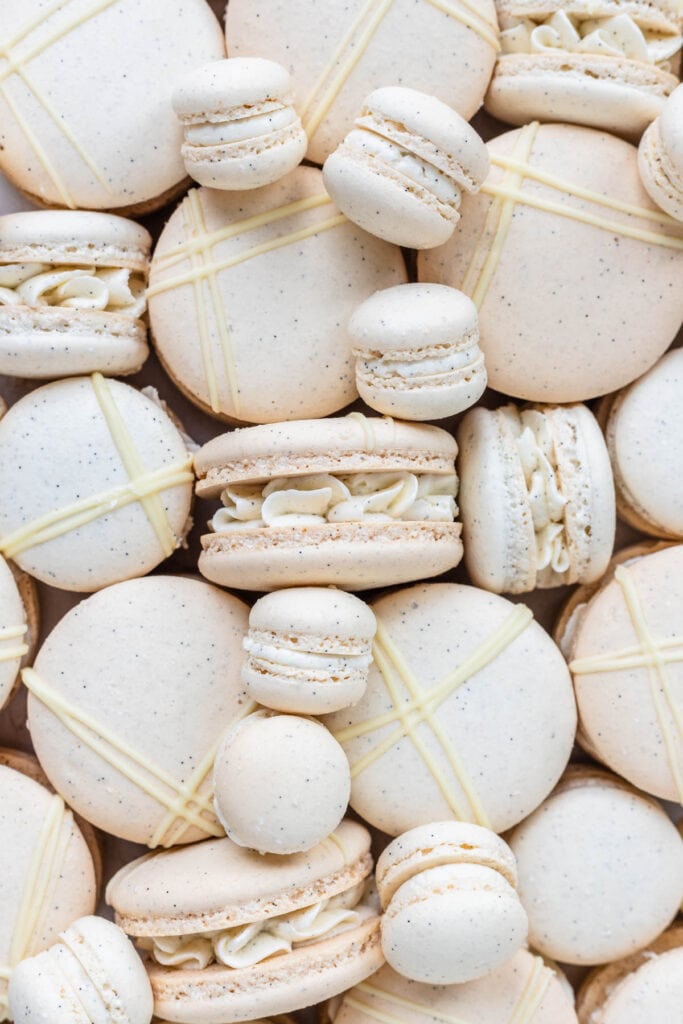
You can’t go wrong with a Vanilla Macaron flavor. Some say it’s too basic, I say it’s absolutely delicious. And there are ways you can make these simple macarons stand out. One of the ways is to add some sort of beautiful decoration to the shells, use a different color for the shells, maybe a super electric purple, or pink.
I’ve decided to keep mine as plain as possible, because there’s beauty in that. I did use a different piping tip to make the filling look a bit fancy, it’s a piping tip 2D. Watch the video on this page or on YouTube to see how I piped the filling. Basically you will pipe a little flower, then another on top, and another on top. And when you place the top shell over it, it will kind of squish it all down, forming the beautiful ruffled filling look.
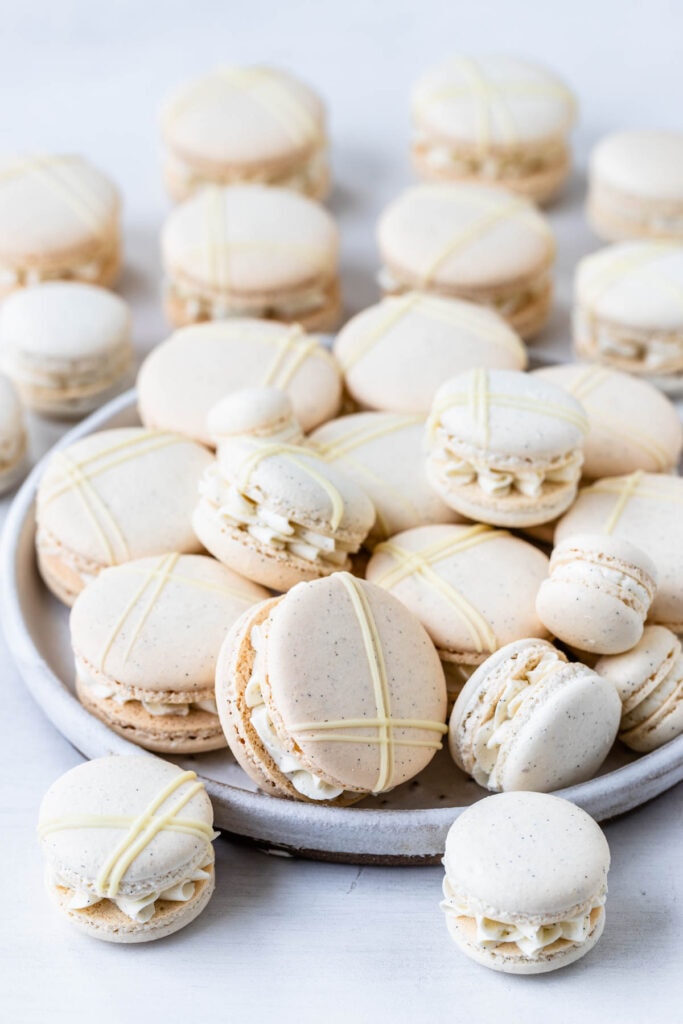
Ok, now since these are Vanilla Macarons, let’s talk about the star of the show, the vanilla.
I wanted the shells to be brimming with vanilla taste and fragrance, which is why I went with vanilla bean seeds. I added the seeds from one vanilla bean to the meringue, once it had almost reached stiff peaks.
You could definitely add a touch of vanilla extract, I wouldn’t go over 1/2 tsp, though.
The vanilla beans give a super cute look to the shells, making them speckled, and also a very delicious taste.
Or, you can leave the shells plain, and focusing on making the best vanilla filling for the shells.
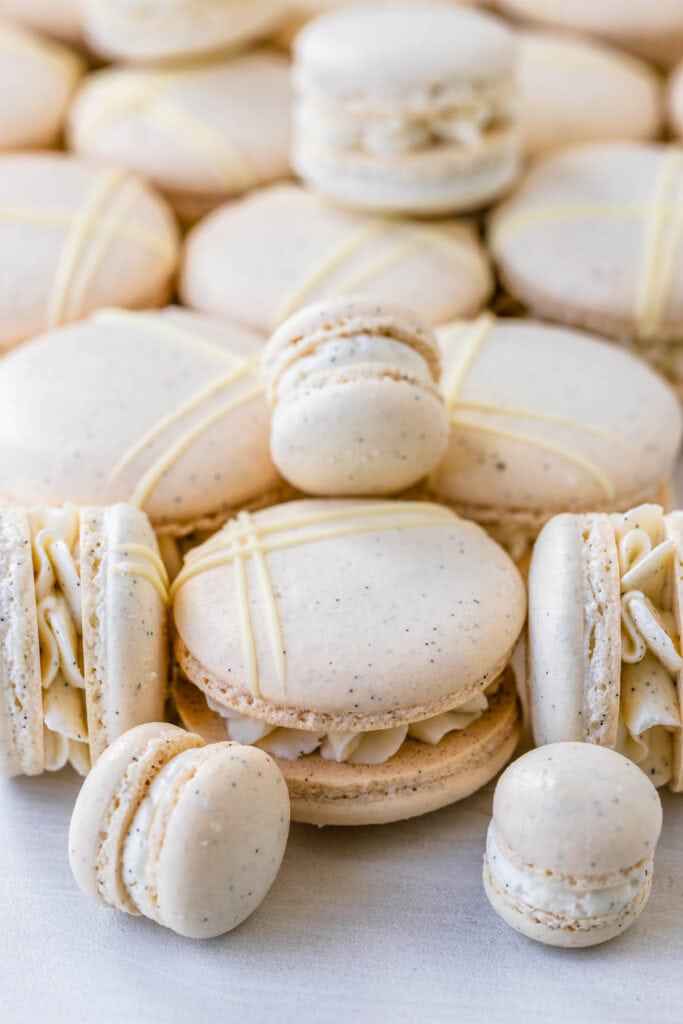
I used a Vanilla Swiss Meringue Buttercream for the filling. Swiss Meringue Buttercream doesn’t take any confectioner’s sugar, it’s made similarly as the meringue for the macarons, by heating up the sugar and egg whites over a double boiler very gently until the sugar has melted and formed a syrup with the egg whites.
The difference here between the meringue for the macarons, and the meringue for the Swiss Meringue Buttercream is, besides the ratio of egg whites and sugar, that we have to heat the syrup for the buttercream to a certain temperature, because remember, the macarons will be baked, but the buttercream will not.
So because of that, we need to heat up the egg whites and sugar syrup until it reaches 140ºF, which will make it safe to be consumed.
After making the syrup, we whip it, as we would whip the meringue for the macarons, but you will notice the meringue won’t get as stiff as the meringue for the macarons.
You absolutely must whip the meringue until it’s stiff, otherwise the buttercream will be soupy, but don’t expect super high peaks standing right up with this one, because the content of sugar is higher than in the meringue compared to the egg whites.
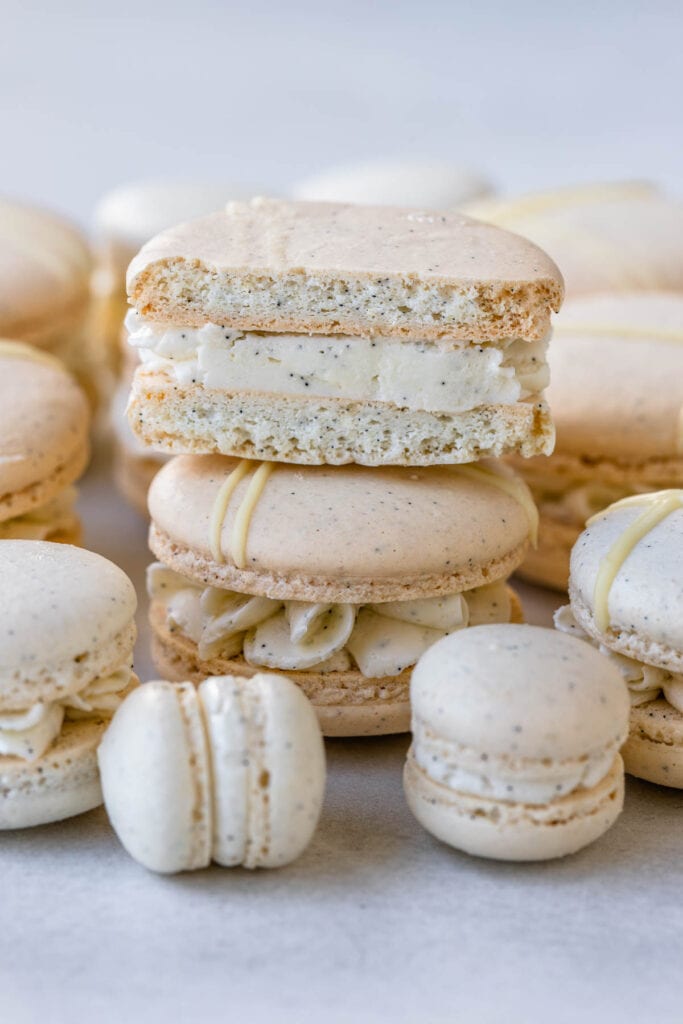
Here are some more tips for making the Swiss Meringue Buttercream:
- Make sure to whip the meringue for the buttercream until it achieves stiff peaks, the peaks won’t be as stiff as the peaks of the macaron meringue, but they do need to be somewhat stiff and glossy, or the buttercream won’t firm up.
- Also ensure to use butter at 72ºF, if the butter is too cold, it will form lumps in the buttercream that won’t dissolve or incorporate, and you don’t want to bite into a lump of butter. And if the butter is too warm, the buttercream will be soupy, like melted ice cream, and won’t come together.
After the buttercream has been whipped, I added some vanilla bean seeds to it along with vanilla extract. However, if you don’t have vanilla seeds, you can use just vanilla extract instead. Just double the amount indicated in the recipe. You can always use vanilla bean paste as well, which is wonderful, tastes super delicious and has the vanilla bean speckles.
Place the buttercream in the pastry bag fitted with the tip of choice. Like I said above, I used a tip 2D by Wilton to make the ruffled effect.
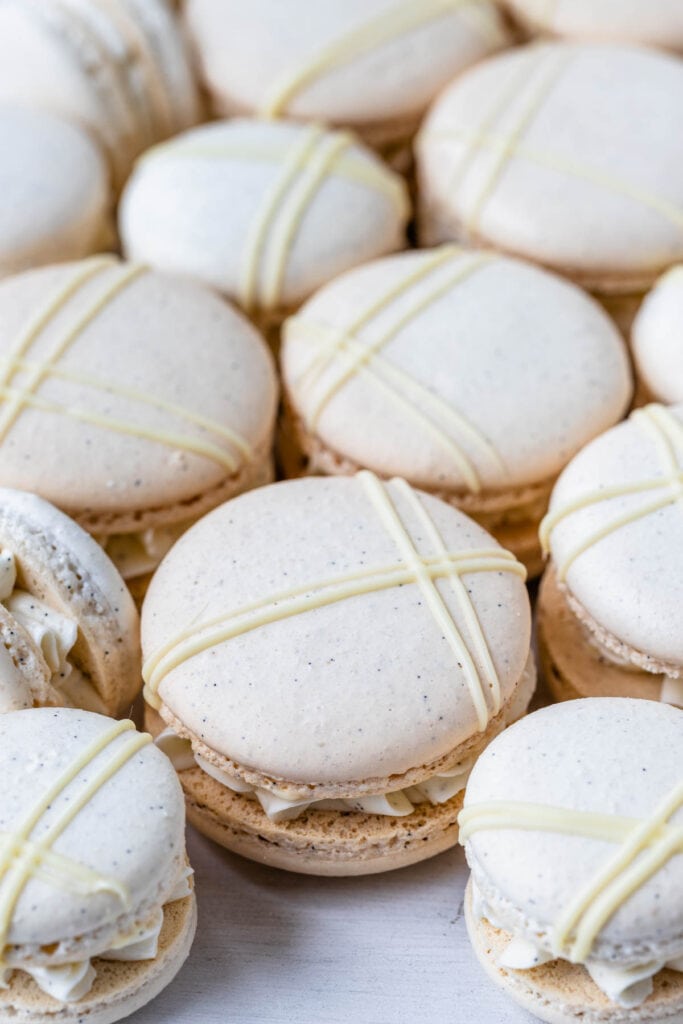
It’s also worth pointing out that I made mini macarons as you can see in the photos. On the video I show the piping of the mini shells, which were baked without resting on my countertop oven for about 13 minutes at 290ºF.
I am not able to do no rest method on my large oven, which is why I got the countertop oven, which allows for me to bake the shells without resting.
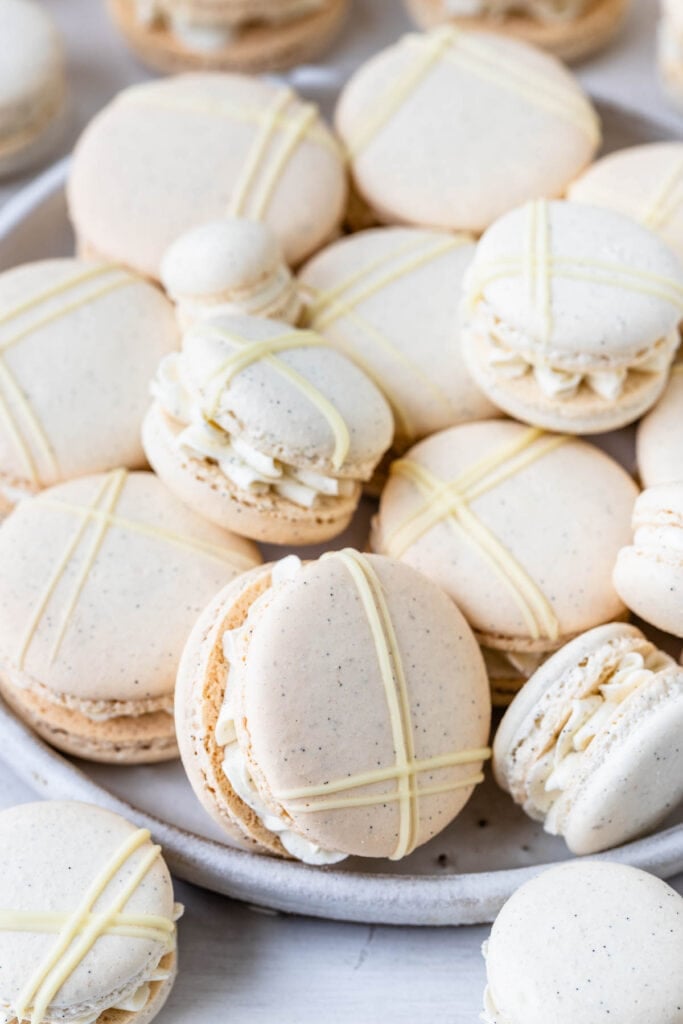
For more vanilla macaron recipes, check out the French Vanilla Macaron recipe filled with a French Vanilla Buttercream, and the Vanilla Bean Macaron recipe, which featured a Vanilla American Buttercream filling and Vanilla Bean Custard.
And to learn more about macarons, check out Macaron School, a place where I post all of my macaron knowledge, troubleshooting guides, the science behind making macarons, my favorite tools, tips, and much more!
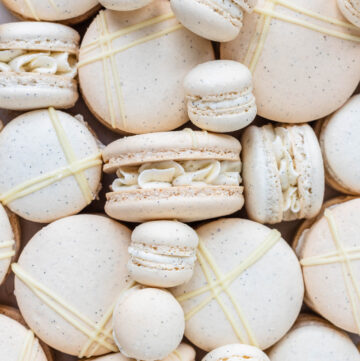
Vanilla Macarons
Ingredients
Vanilla Shells
- 100 grams white granulated sugar
- 4 grams egg white powder optional *read notes
- 100 grams egg whites
- 105 grams almond flour
- 105 grams powdered sugar
- Seeds from 1 vanilla bean optional *read notes
- Food coloring if desired
Vanilla Swiss Meringue Buttercream
- 2 large egg whites
- 133 grams granulated sugar
- 170 grams unsalted butter at precisely 72ºF
- Seeds from 1 vanilla bean
- 1 tsp vanilla extract *read notes
Decoration
- 1/3 cup white chocolate
Instructions
Prep the ingredients and tools
- Before you start, get all of the ingredients ready. Prepare a large piping pastry bag, fitted with a large round tip, I use a 1/4” diameter tip, or a Wilton 12. Set aside.
- Line two baking sheets with parchment paper or silicone mat.
- I use a baking mat with the macaron template already in it.
- Wipe the tools such as bowls, spatulas, and silicone mats with vinegar if desired, this helps getting rid of any grease particles that might be in the tools.
- Measure out all of the ingredients.
- Split the vanilla bean in half and scrape the seeds out.
- Sift the powdered sugar and almond flour together. Set it aside.
- Start pre-heating the oven. I pre-heat my large oven to 310ºF for 60 to 90 minutes, this helps with temperature fluctuations. I pre-heat the countertop oven for 30 to 45 minutes.
Making the Swiss Meringue
- Place a bowl over a pan with barely simmering water. Add the sugar and egg white powder to the bowl if using. If you’re not using egg white powder simply skip it, nothing needs to be changed in the recipe.
- Whisk the sugar and egg white powder so it doesn’t clump up.
- Add the egg whites to the bowl and whisk until the sugar is completely melted. It will take a couple of minutes. You can test by touching the mixture between your fingers, and if you feel any sugar granules just keep whisking the mixture over the water bath.
- Make sure the bottom of the bowl isn’t touching the simmering water because you don’t want the whites to cook.
- Also, don’t overheat the sugar syrup, you are just looking to melt the sugar, no need to bring it to a certain temperature.Transfer the syrup to the bowl of a stand mixer. Before transferring the syrup, you might consider whipping the bottom of the bowl with a towel so the water doesn’t fall into the mixer bowl.
- With the whisk attachment, start whisking mixture on low (speed 2 of the KitchenAid) for about 30 seconds, then gradually start increasing speed to medium. Whisk on medium (speed 4) for one to two minutes, until the mixture is white and starting to become fluffy. Raise the speed to medium or medium-high and whip for a few minutes until stiff peaks are formed. I like to finish whipping the meringue on speed 6 of the KitchenAid.
- When the meringue is almost done whipping, add the vanilla bean seeds and continue to whip until stiff. If not adding vanilla bean seeds, you may add 1/4 to 1/2 tsp of vanilla extract, or simply leave it out for plain shells.
- It takes me about 13 to 15 minutes to whip the meringue, but you shouldn’t go by time, go by what the meringue is supposed to look like because a lot of things can affect whipping time, such as the quality of the eggs, the weather, how powerful your mixer is, and more.
- Once the meringue gets glossy and you start seeing streaks formed by the whisk, and the meringue raising in the center of the whisk, it might be time to stop.
- You don’t want to over whip the meringue at this point because that can cause several issues, mainly hollow macarons.
- Whisk until stiff peaks have formed. When you pull the whip up, the peak should be stiff and shooting straight up, with possibly a slight bend at the top, but not bending to the side.
- Also when you swirl the whisk around in the bowl to collect the meringue, you should feel some resistance from the meringue. And when you look on the bottom of the whisk the meringue collected should be forming soft but defined waves.
Macaronage
- Pour the sifted powdered sugar and almond flour into the stiff meringue.
- Add the food coloring at this point, if using. I added a teaspoon of white powder food coloring by the Sugar Art.
- Start folding gently forming a letter J with a spatula.
- Once the dry ingredients have incorporated with the meringue, you can start squeezing the air out of the batter by pressing it down along the sides of the bowl as you fold.
- How to know when to stop folding the batter: It’s time to stop folding when the batter is glossy and has a thick and flowing consistency. There are several ways to test this.
- First, pick up some batter with the spatula and try to draw a figure 8 with the batter that is dripping off the spatula. If you can form several 8 figures without the batter breaking up, that’s one indication that it might be ready.
- The batter that’s falling back into the bowl should take 10 to 15 seconds to incorporate with the batter that’s already in the bowl.
- There’s another test you can do. I call it the Teaspoon test. Grab a teaspoon of batter and spoon onto the parchment paper or silicon mat. Wait a minute to see how it behaves.
- If the batter stays stiff, forming a point and doesn’t spread out, fold a little bit more, about 3 folds.
- Test again.
- Once the batter spreads out a bit and starts to look glossy and smooth on top, on the parchment paper or silicone mat, it’s ready.
- You don’t want your batter to be too runny either. So be careful not to over mix. It’s always best to under mix and test several times until the proper consistency has been achieved.
- When you hold the spatula with batter on top of the bowl and the batter falls off the spatula slowly but effortlessly the batter is ready. The batter will keep flowing off the spatula non-stop, but not too quickly.
- Transfer the batter to the piping bag. I also like to seal the top with a bag tie, so the batter doesn’t dry out and it gives you more control while piping because there’s no risk of the batter escaping through the top of the piping bag.
- Place the piping bag directly 90 degrees over the center of each macaron template. Apply gentle pressure and carefully pipe for about 3 to 5 seconds, and then quickly pull the bag up twisting slightly at the top.
- Once you’ve piped as many circles as you could, bang the trays against the counter or against the palm of your hand a few times each.
- Use a toothpick to pop any air bubbles in the surface of the shells.
Resting or not resting the shells
- Let the trays sit for a while so the shells will dry out before baking, if you are resting the macarons. I usually leave about 20-40 minutes, depending on how humid the day is. You’ll know they’re ready when you gently touch the surface of a macaron and it seems dry.
- To do the no-rest method, you can bake the trays immediately.
- The no-rest method will depend on your oven and baking sheets you are using. Read the post above for more information.
- I can do the no-rest method on my small counter top oven, but not on my large oven, because the temperature is too uneven on the large oven.
Baking
- On my large oven I bake the macarons at 310ºF, and on the small countertop oven I bake them at 290ºF. I pre-heat both ovens for quite a bit of time. I pre-heat the large oven for 60 to 90 minutes, and the small oven for 30 minutes or so.
- Bake one tray at a time.
- Bake for 5 minutes, rotate the tray. This step is not necessary, I don’t rotate the trays on the small oven, but I have to do so on my large oven, otherwise the macarons will be lopsided. Not all bakers have to rotate the tray.
- I bake each tray for about 15 to 20 minutes.
- When baked, the macarons will have a deeper color and formed feet. If you try to move a macaron, it shouldn’t feel jiggly. If the macaron is still jiggly, keep baking. Also try to touch the top of a macaron and it shouldn’t feel soft, if it’s still soft, keep baking.
- Remove from the oven and bake the other tray.
- Let the macarons cool down before proceeding with the filling.
Storage
- I store the unfilled shells in an air tight container in the fridge for up to 5 days, and in the freezer for 1 to 2 months.
Vanilla Swiss Meringue Buttercream
- Make sure the butter is at 72ºF for the recipe to work, if the butter is cold, it will form lumps in the frosting and not incorporate well, and if it’s too soft, the buttercream won’t firm up.
- Put the whites and the sugar in a heatproof bowl.
- Place the bowl on top of a small pot with simmering water.
- Whisk the whites and sugar until they temp 140 Fahrenheit. Basically you are looking to melt the sugar granules, and also make it so the egg white is in a safe temperature to be consumed.
- Once you achieve that temperature, transfer the syrup to your mixer bowl.
- Whip with the whisk attachment for about 2 minutes at medium speed, until the mixture looks white, and thicker. At this point, raise speed to high and continue to whip until fluffy and doubled in size. The meringue should have stiff peaks. It can take anywhere from 5-10 minutes to obtain stiff peaks. The peaks won’t be as stiff as the peaks of the meringue we made for the macarons, but they should be firm.
- Test every so often, so you don’t over whip it. Also, it’s best to use a hand mixer instead of the kitchenaid considering that it’s just one egg white and the kitchenaid whisk might not reach the bottom of the bowl.
- Cut the butter into very thin pats. Starts adding one by one to the meringue with the mixer running on medium-high.
- Wait for one butter pat to be incorporated before adding the next one.
- By the end, the butter should have incorporated with the buttercream, which will be creamy and fluffy. Add vanilla beans and the vanilla extract and mix to combine. If not using vanilla beans, up the quantity of vanilla extract to 1 tsp.
- Place the buttercream in a piping bag fitted with the tip of choice. I used a 2D by Wilton.
Decoration
- Melt the white chocolate in the microwave. Place it in a piping bag, and then snip the end with scissors, and drizzle the white chocolate over the shells.
To fill
- Pipe the filling on the bottom shells and then top with a decorated shell.
Maturing
- Let the macarons mature in the fridge overnight, or longer before serving.
Storage
- Store the macarons in the fridge in an air tight container for up to 4 or 5 days, and in the freezer for up to 1 or 2 months.


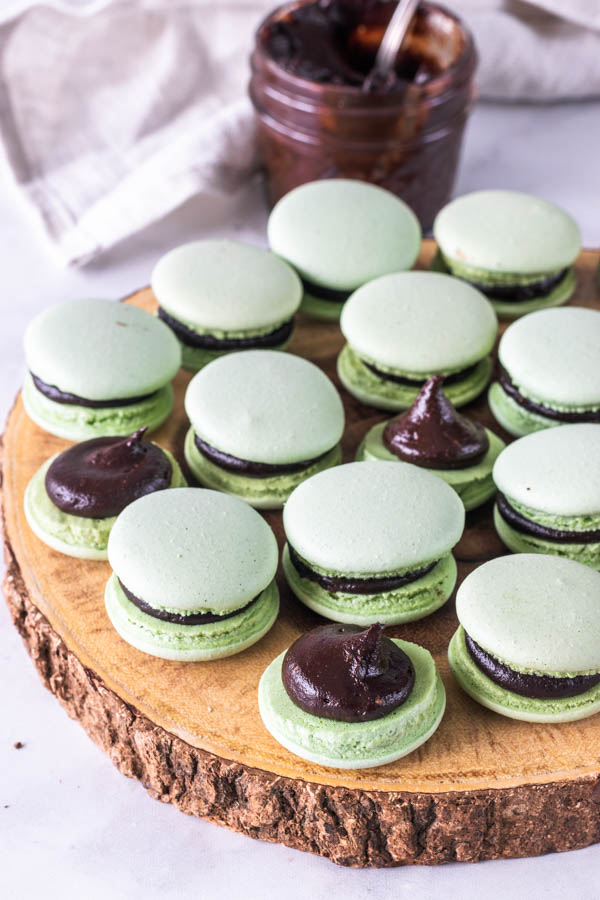
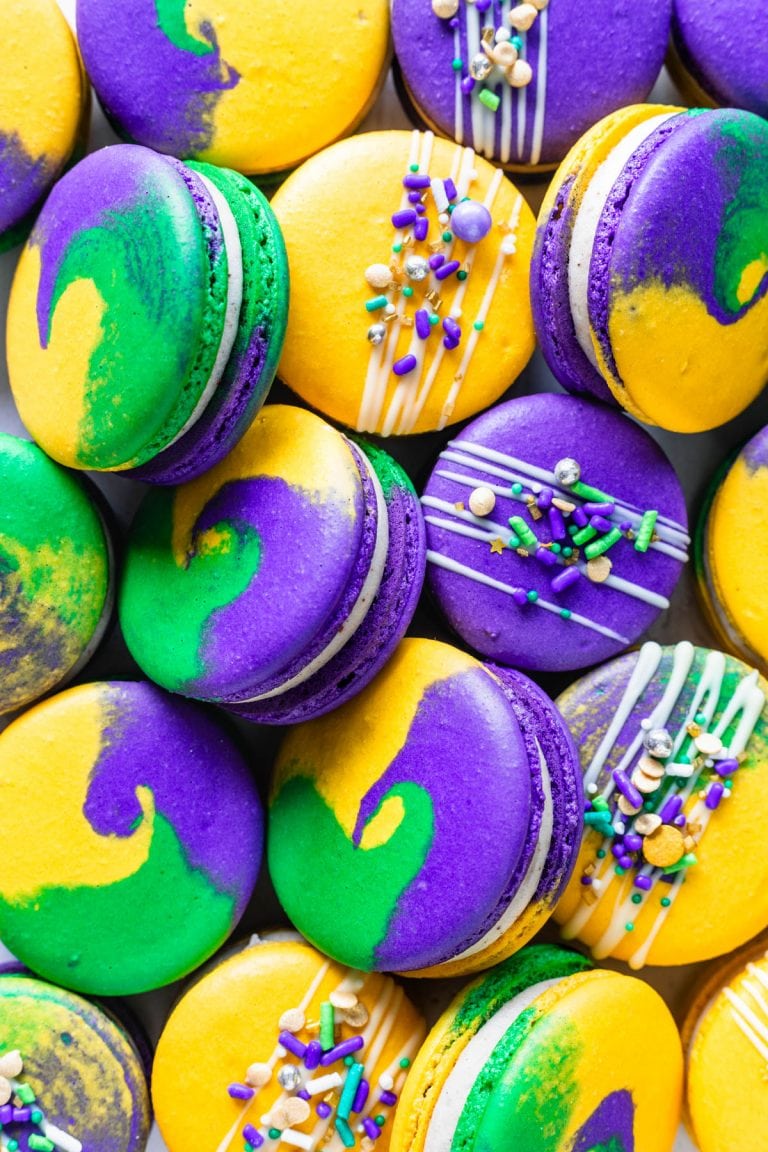
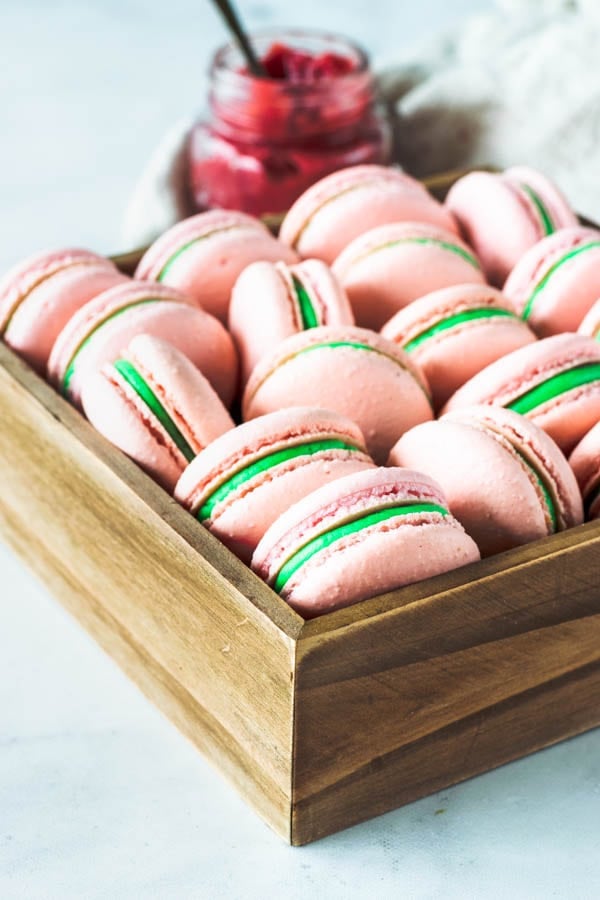

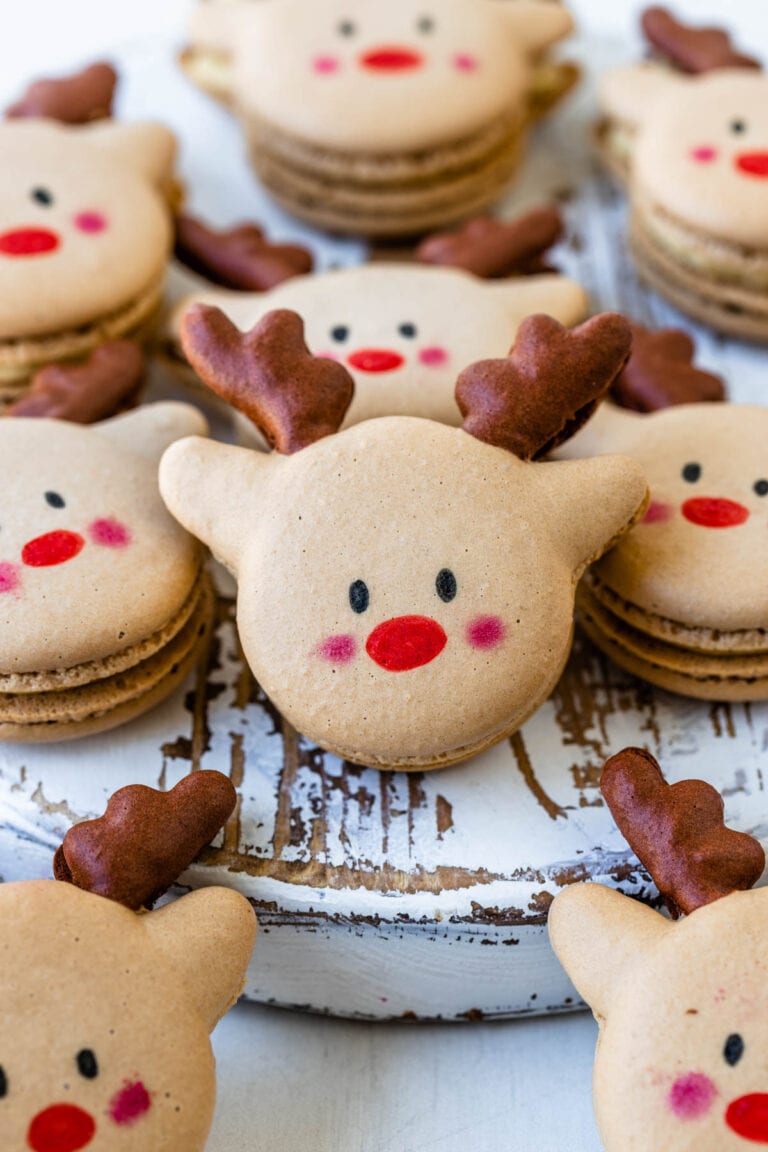
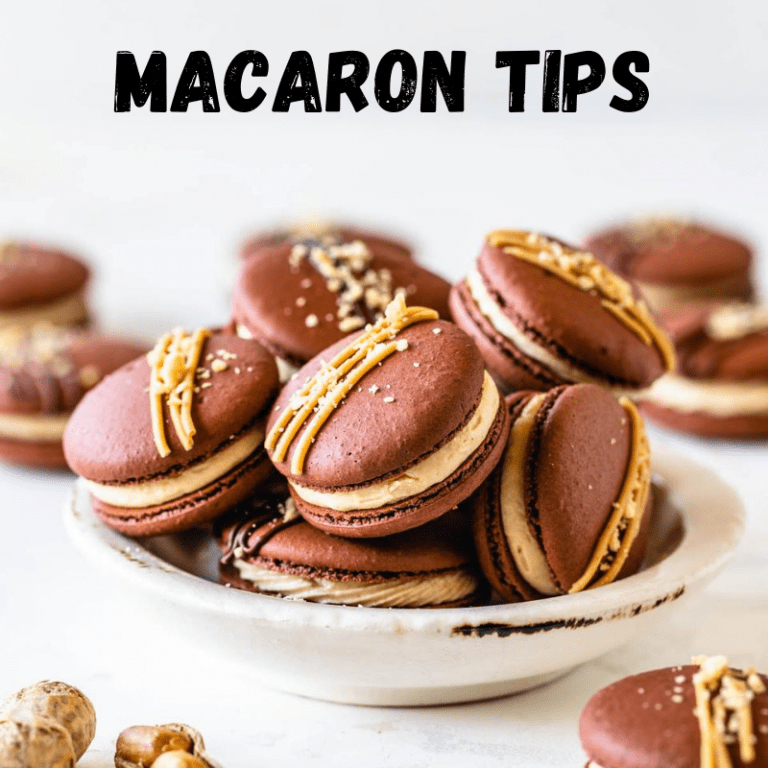
Receita fantástica!!!!!!!!
These turned out perfect and delicious! I love the detailed instructions.
Thank you so much!!!
Help! I followed the steps and it seemed to have too Much air no matter how much mixed it! So many air bubbles and they came out very bumpy! I did add a small amount of Vanilla but did it as suggested. Any ideas?
probably over whipped meringue.
Great recipe! I prefer the Swiss meringue over the American. Is it possible to substitute the American buttercream in your other recipes with this one and adding for example freeze dried strawberry powder to this one?
Thanks a lot for your recipes!
yes absolutely!!!
I’d like to make this more of a wedding cake flavor with almond extract. How much would you add to the shells and the buttercream?
to the shells no more than 1/4 tsp of almond extract. And to the buttercream I’d add like 1/2 tsp of almond extract.
I know most of your recipes say bake at 325. Wondering why this one is less. I seem to be having issues with the heat in my oven being inconsistent so wondering if the lower temp would help me with other flavors too, or if this particular temp drop is due to specific ingredients in these?
because I moved to a different house where the new oven requires a lower temperature because 325 was too high for this oven. definitely play around with lower temperatures.
Hi, when freezing the shells do you mature them first or will they mature as they defrost? Thanks!
if they are filled yes I do mature them before freezing.
Is vanilla bean paste an option instead of scraping a bean? If so, how much would you recommend adding?
check the ingredients of the paste, because if there are oils in there, dont add to the batter or it will ruin it. So if its just the extract type, you can add about 1/2 tsp, its best not too add too much.
Another fabulous recipe – I am learning so much from you. Thank you, thank you! This was my first attempt at the Swiss meringue buttercream and it was a success and SO delicious! Not sure I can go back to American. I have a lot of leftover vanilla Swiss meringue buttercream. I noticed the recipe measurements are different from the chocolate Swiss meringue buttercream. Do you you have any suggestions on adding ganache to this leftover buttercream here to make it chocolate?
So the reason why there’s leftover is that when making the recipe with just one egg white, often times it won’t work for a lot of people, it makes it harder to achieve the proper consistency for the meringue and buttercream, so to avoid that I doubled the recipe because this freezes so well, you can place it in the freezer for months. And yes you can add melted dark or milk chocolate to the leftover, or anything really, even caramel or dulce de leche to make it a different flavor. I am not sure how much leftover you have but adding a couple tablespoons at a time until you feel like the flavor and consistencies are what you are looking for.
That makes sense. We like leftover icing and always find a use for it. Thanks for the tip. I made ganache and let it come to room temp and added it slowly to the buttercream and it came out spot on.
My gosh these look amazing!!! Absolutely beautiful im nervous but I can’t wait to try them when would be best time to add gel coloring?
I add it when I start the macaronage. Could be added towards the ending stages of the meringue whipping.
Your recipes are always work out perfectly! I love them all! Thank you.
I am so happy to hear that! Thank you!!